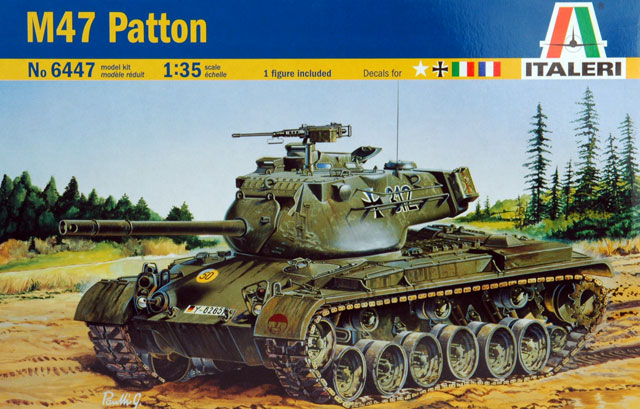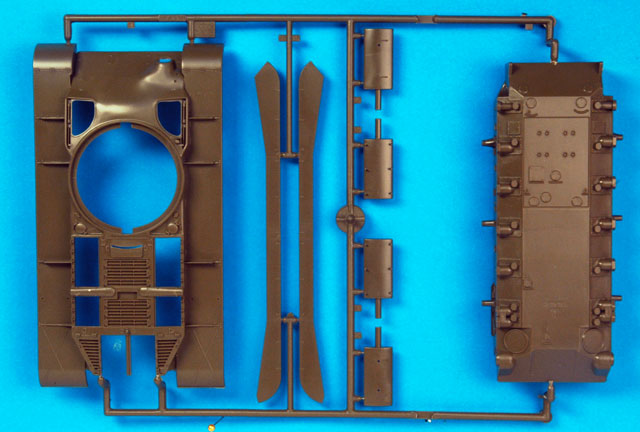
M47 Patton
Reviewed by Cookie Sewell

Summary
| Stock Number and Description |
Italeri 1/35 Scale Kit Number 6447 - M47
Patton (also released as Italeri Kit No. 208, Kit No. 265, and Testor/Italeri
Kit No. 802) |
| Scale: |
1/35 |
| Media and Contents: |
275 parts (273 in either green or olive
drab styrene, 2 in black vinyl) |
| Price: |
price, current release about US $38; older
kits available at shows for $10-20 |
| Review Type: |
First Look |
| Advantages: |
Best kit Italeri ever produced, still state
of the art today |
| Disadvantages: |
Some problems with sink marks, static
figure pose |
| Recommendation: |
Recommended for German armor fans or
beginning modelers |
FirstLook
The US Army was not well prepared
for WWII, and even the much improved M4 Sherman was found to be
lacking in many areas of combat capability. In late 1942 efforts
began to find a better design of tank that would be able to counter
German improvements, and it resulted in the T20 series of prototype
tanks. The tanks basically combined Sherman parts on a new, lower
chassis with a Ford GAA engine that later found its way into the
M4A3 series tanks. The design morphed into the T22 series and
finally to the T23, which combined a new electric drive system with
a new turret mounting the 76mm M1 gun with much higher velocities
than the M3 75mm gun of the Sherman.
While 250 T23s were built, and would have become the M27 medium
tank, events in Europe showed it would only have been a faster
version of the Sherman, and so two new tanks were developed from it,
the 34-ton T25 medium and 45-ton T26 heavy tank. The T23E3 had shown
the viability of torsion bar suspension on this hull, so it was used
on the two new designs. The T25 series did not show much promise,
but the T26 did as it now mounted a 90mm gun with relatively heavy
armor protection. After some evolution, the T26E3 was adopted as the
M26 Pershing, seeing combat at the very end of WWII.
The M26 turned out to be an excellent tank with one glaring flaw –
it was woefully underpowered. As a result, in late 1945 a modified
version of the tank was ordered, the M26E2, which used a new
Continental AV-1790 engine of 740 HP and a CD-850 automatic
transmission. An improved version, the T40, began testing at APG in
August 1949. The major difference between it and the M26E2 was an
improved version of the engine and transmission, and a new track
tension adjustment roller to reduce the tendency to throw track on
rough terrain. The tank now had a totally new back end and engine
deck, as the AV-1790 was air cooled and did not have the radiators
used by the Ford GAM from the M26. With some modification, the T40
was accepted for service as the M46 Patton in November 1949 (it had
been approved pending testing in July 1948.)
When the Korean war broke out, the M46 was in production and
consideration was made of converting M26s to take the new engine and
transmission. Problems that surfaced with both tanks showed a new
tank with more modern features was desirable, including a
cross-turret stereoscopic rangefinder. Another experimental tank,
the T42 with a new 90mm turret on a smaller chassis, was in testing,
but based on the exigencies of the time it was decided to mount this
turret on an M46A1 chassis to get an interim new tank dubbed M46E1
(the projected final design, the T48, emerged several years later in
April 1953.) The interim tank, now designated as the M47, was
accepted for service on 1 November 1950. Over the next two years,
8,576 M47 tanks were built.
The tank served with the US Army for more than 10 years active and
reserve, and was one of the main vehicles to be provided under the
Military Assistance Program to NATO and other friendly countries
(France, Italy, Spain, and Belgium among others.) It served with
Jordan in the Middle East, and also was upgraded in the 1970s with
more modern diesel AVDS engines, acquiring an engine deck shape
similar to the M48A3 and M60 series. It was also upgunned, some
later conversions mounting the L7-based M68 105mm tank gun.
The M47 was one of the few tanks to serve in the US Army in only one
version and without major changes. But due to its wide distribution
under MAP, it can be found in a relatively large number of colorful
schemes. Other than the conversions, the only major difference seen
on MAP tanks is a set of rain gutters mounted on the side of the
turret, used in conjunction with a tarp when the tank is in storage.
The Italeri M47 kit came out in the late 1970s, and has been through
a number of reissues to include one by Testors in 1979 (which this
review is based upon). While it was the only kit that Italeri made
based on this chassis, it was also arguably their best kit ever and
stands up today as hard to beat. It does suffer a bit from sink
marks on heavier moldings, and ejection pin marks as well as a seam
clean-up problem along the joint line of the turret, but overall it
is a very good kit and shows it.

Click the thumbnails below to view
sprue images:
The kit comes with a number of
flexible options, one of the more interesting being a basic engine
compartment with engine and transmission, and six optional position
engine deck grilles to display it. This is a detailer's delight, as
the basics are there and one only has to add wires, cables, and some
detail painting to make it come to life.
The hatches are all separate parts, and little things are also
covered. The short-barreled bow machine gun may be left movable, and
Italeri has done a reasonably good job of getting it to replicate
the casting on the original. The exhausts come with fairly
respectable shrouds (one of the problems with the M46 in Korea was
that the mufflers would glow cherry red at night, attracting
Communist artillery fire) and have hollow-molded pipes. Fender
skirts are included, and the stowage bins all have separate locking
handles. Only the OVM (pioneer tools) look a bit wimpy, and a
diehard detail fan may want to replace them.
The turret is pretty well done, and captures the shape of the T42
turret. The mantelet needs some careful cleanup. The M3A1 90mm gun
includes a basic breech end with crew guards, and to cover the
different periods in the life of the M47 three different muzzle
brakes are included – cylindrical, flared, and T-shaped. The M2HB
machine gun was good for the 1970s, but today modelers may want to
replace it with one from the Academy US Machine Gun Set.
The running gear is nicely reproduced, with the correct shapes and
pin heads, and unlike many other Italeri kits the vinyl T84 style
tracks (23" with rubber chevron blocks) are among the most flexible
of Italeri's tracks due to their relatively faithful representation
of the originals – each block is joined to its neighbor by a center
guide and two end connectors, with daylight visible between each
block. (These tracks are also quite useful for conversions, as they
are easy to join together by simply inserting brass wire pins
through the end connectors into the blocks, but that's another
story...) Since the M47 used "live" track, there is no real reason
to replace these tracks with single-link types.
A single infantry figure is included, but he reflects the style of
the early 1970s and is somewhat static in pose. While better than
contemporary Tamiya figures, he isn't up to today's standards.
Four different finishing options are included, but Italeri didn't do
a good job on the decals the first time around and hasn't gotten any
better. They cover a tank from the 143rd Tank Battalion (no bumper
codes or unit codes included), one from the 2nd Panzergrenadier
Division of the Bundeswehr (no unit codes), one from the Italian "Ariete"
division, and one from the French 1st DB. The latter two, based on
photographs, also appear short on markings.
In summary, this is a great kit and a fun build, and one that can be
built pretty much right out of the box less the decal shortcomings.
Highly Recommended
|